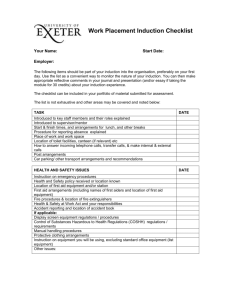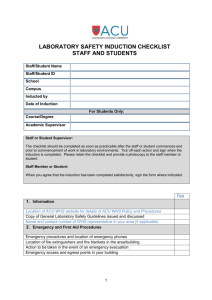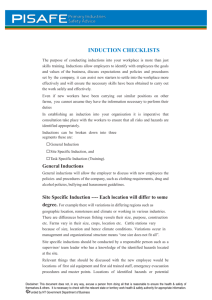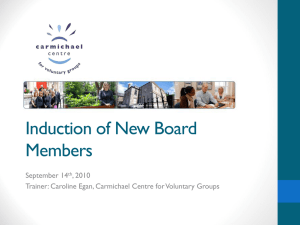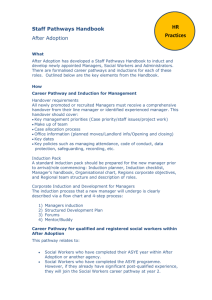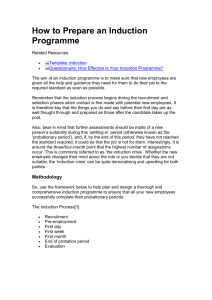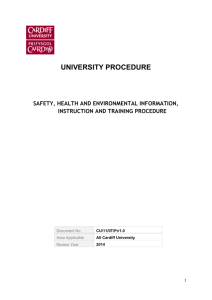3.3 Best practice tips for conducting the employee induction guide
advertisement
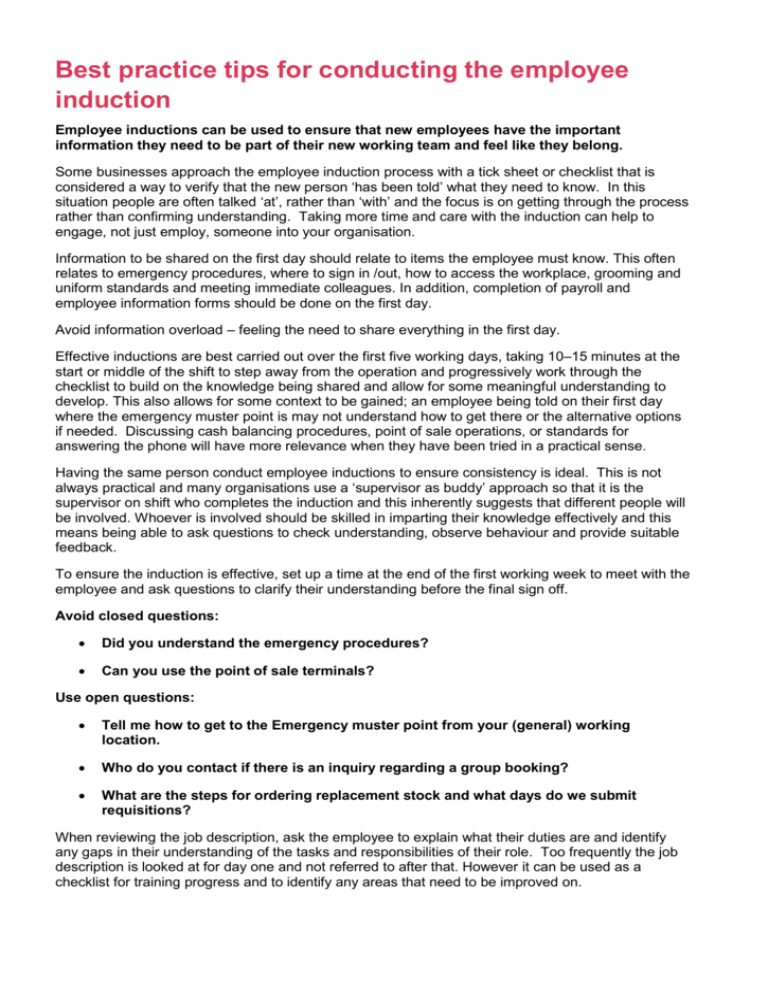
Best practice tips for conducting the employee induction Employee inductions can be used to ensure that new employees have the important information they need to be part of their new working team and feel like they belong. Some businesses approach the employee induction process with a tick sheet or checklist that is considered a way to verify that the new person ‘has been told’ what they need to know. In this situation people are often talked ‘at’, rather than ‘with’ and the focus is on getting through the process rather than confirming understanding. Taking more time and care with the induction can help to engage, not just employ, someone into your organisation. Information to be shared on the first day should relate to items the employee must know. This often relates to emergency procedures, where to sign in /out, how to access the workplace, grooming and uniform standards and meeting immediate colleagues. In addition, completion of payroll and employee information forms should be done on the first day. Avoid information overload – feeling the need to share everything in the first day. Effective inductions are best carried out over the first five working days, taking 10–15 minutes at the start or middle of the shift to step away from the operation and progressively work through the checklist to build on the knowledge being shared and allow for some meaningful understanding to develop. This also allows for some context to be gained; an employee being told on their first day where the emergency muster point is may not understand how to get there or the alternative options if needed. Discussing cash balancing procedures, point of sale operations, or standards for answering the phone will have more relevance when they have been tried in a practical sense. Having the same person conduct employee inductions to ensure consistency is ideal. This is not always practical and many organisations use a ‘supervisor as buddy’ approach so that it is the supervisor on shift who completes the induction and this inherently suggests that different people will be involved. Whoever is involved should be skilled in imparting their knowledge effectively and this means being able to ask questions to check understanding, observe behaviour and provide suitable feedback. To ensure the induction is effective, set up a time at the end of the first working week to meet with the employee and ask questions to clarify their understanding before the final sign off. Avoid closed questions: Did you understand the emergency procedures? Can you use the point of sale terminals? Use open questions: Tell me how to get to the Emergency muster point from your (general) working location. Who do you contact if there is an inquiry regarding a group booking? What are the steps for ordering replacement stock and what days do we submit requisitions? When reviewing the job description, ask the employee to explain what their duties are and identify any gaps in their understanding of the tasks and responsibilities of their role. Too frequently the job description is looked at for day one and not referred to after that. However it can be used as a checklist for training progress and to identify any areas that need to be improved on. New employees generally have a three to six month probationary period and this time should be taken as a time frame for both parties to determine if they have made the right employment choice; for the employee to consider if this is an ideal working place for them, and for the employer to confirm their recruitment selection. The time can be broken into three sections: Initial induction Up to five working days Complete induction checklist Ensure payroll details are accurate and updated Issue of uniform / name badge and any security / IT codes issued Employment contract & Job description are signed and added to personnel file Confirmation of date for “qualifying review”. Interim qualifying the probationary period Up to three months Review the induction checklist to confirm continued understanding within context of role. Review job description and any job training checklists to identify if there are any training needs / support required for the employee to perform in their role. Clearly identify any concerns that may have been noticed by the manager / supervisor so that employees have an opportunity to respond and improve / correct their behaviours. Confirm the positive aspects of behaviour and encourage the continuation of desired behaviours. Confirmation of employment Up to six months Conduct a review of performance in context of their effectiveness in the role and ‘fit’ within the organisation. A letter of confirmation of ongoing employment may be issued. Confirmation of future reviews and ongoing feedback systems. By working within this framework, employers are making sure that they are effectively managing their employees. In the event that a decision is made not to continue with employment during the qualifying period there is evidence of having provided opportunities for employees to seek assistance and/or express any concerns they may have. In addition, the employer is providing evidence of a supportive working environment and relying on open communication to achieve agreed goals of working to an established job description and internal procedures. When commencing employment, both parties should be working on the expectation of developing a cohesive working relationship. To achieve this, both parties should use the induction and qualifying time as a way to ensure that all information is shared and explored so there are no barriers to becoming an effective part of the team as soon as possible. An effective performance management system will include opportunities beyond the initial induction and qualifying period to allow for focus on continued skills development and planning for future pathways within the organisation. Note: the amount of time available for a ‘qualifying period’ will be determined by the contract of employment. It may not be a full six or three months term and advice here should be taken in consideration of your organisational policies. Source: CHARTTES Training Advisory Council - Creative and Cultural, Sports and Recreation, Tourism & Hospitality, ‘Conducting the Employee Induction – Best Practice Tips’. CHARTTES Training Advisory Council provides assistance with workforce planning and development strategies for the Hospitality Industry.

